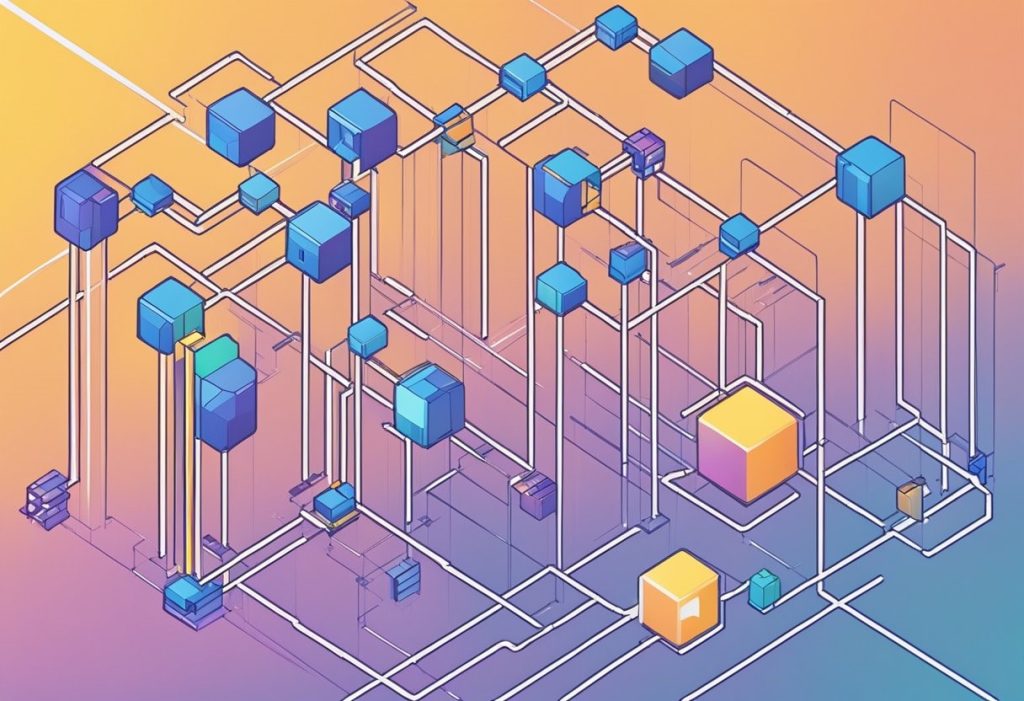ChiaLisp is rapidly redefining the landscape of blockchain technology with its unique approach to on-chain programming. Developed specifically for the Chia Network, ChiaLisp is a powerful programming language that offers a level of security and audit-ability in stark contrast to some existing blockchain solutions. Its design philosophy emphasizes simplicity and efficiency, yet it doesn’t compromise on the functionality and broad applicability required for complex, secure, and high-quality smart contracts. This specificity is integral to fostering transparency and protection for consumers, placing it ahead in the race to build trust within the blockchain space.

With an inherent focus on scalability and developer-friendliness, ChiaLisp presents a robust alternative for decentralized applications (dApps). Its launch marked a significant shift towards a more functional paradigm in blockchain programming, challenging the dominance of established languages like Solidity. Additionally, the introduction of ChiaLisp paves the way for innovative decentralized finance (DeFi) solutions, grounded in a programming environment that maintains high security and enables sophisticated on-chain logic without extensive computational overhead. This capacity to harness the potential of smart contracts while mitigating risks positions ChiaLisp as a transformative force within the blockchain ecosystem.
Key Takeaways on ChiaLisp
- ChiaLisp enhances blockchain security and efficiency through its innovative programming framework.
- The language is strategically designed to advance smart contract development and expand DeFi solutions.
- ChiaLisp is set to be a transformative force in blockchain, driving a shift towards more secure and scalable applications.
Fundamentals of ChiaLisp

ChiaLisp is a programming language developed for the Chia blockchain. It operates in a unique niche, designed to be simple yet efficient, optimizing for security and broad functionality. Underpinning ChiaLisp is the core philosophy: to enable secure transactions that are both verifiable and auditable.
The syntax of ChiaLisp bears resemblance to the classic Lisp language, facilitating the creation of smart contracts. These contracts, or “smart coins,” on the Chia network are controlled by code that specifies the conditions required for the movement of digital funds.
Essential Components of ChiaLisp include:
- Puzzles: Chia blockchain coins are associated with Chialisp programs known as puzzles. These determine how and when coins can be collected or spent.
- Solutions: To unlock a coin’s value, a solution that satisfies the puzzle’s conditions must be provided.
- Mod operator: It is used to write adaptable puzzles that accept arguments to tailor the puzzle’s functionality.
Chialisp’s design embraces Turing completeness, which means it can compute anything given the necessary resources and time. This concept is central in blockchain technologies, establishing ChiaLisp as a potent tool for developers.
Developers appreciate Chialisp’s purity and functional style, which contribute to its robust security and ease of auditing — a critical advantage for finance-based applications. For those looking to dive into its practical use, extensive documentation on Chialisp is available, along with primer guides that teach the basics of the language.
Through expressiveness and security, ChiaLisp aims to revolutionize the development of smart contracts, maintaining a strong emphasis on efficiency and functionality essential for the blockchain landscape.
Smart Contracts in ChiaLisp
In ChiaLisp, smart contracts are often referred to as smart coins. These contracts encapsulate the logic for how coins can be spent on the Chia blockchain, providing developers with a versatile toolset for creating decentralized applications.
Creating Chialisp Contracts
When developers create Chialisp contracts, they craft intricate conditions under which Chia coins, or mojos, can be spent. Writing a smart contract in Chialisp typically involves defining several high-level functions that determine the spending behavior of the coin. For instance, a developer might define conditions such as signatures needed or puzzles to solve, which lay the foundational rules for the contract.
Deploying and Interacting with ChiaLisp
Deploying a smart contract to the Chia blockchain involves currying functions with specific parameters and creating a Chialisp puzzle. This puzzle hash is a representation of the conditions placed on the coin. To interact with a smart contract, one must provide a solution that satisfies the conditions defined by the puzzle, thereby unlocking the coin for spending.
Security Considerations of ChiaLisp
Security in Chialisp contracts is paramount, as with all blockchain technologies. One must ensure that contracts are not susceptible to common pitfalls like reentrancy attacks or loopholes in logic. It is also crucial to recognize common gotchas, such as the treatment of curried parameters, and adhere to best practices to maintain contract integrity.
Advantages Over Traditional Smart Contracts
Smart contracts in Chialisp offer several notable advantages: Their Lisp-based structure results in clarity and conciseness which can make the contracts less prone to ambiguities. Moreover, the Chia blockchain’s unique consensus mechanism may enhance energy efficiency, contrasting the more energy-intensive proof of work systems, thereby positioning Chialisp as a more environmentally sustainable option.
ChiaLisp Syntax and Structure
ChiaLisp introduces a unique approach to smart contract language structure with its syntax optimized for blockchain applications. It is crucial for developers to grasp the nuances of its syntax and structure for effective programming on the Chia blockchain.
Basic Syntax
ChiaLisp employs a prefix notation that can initially appear unconventional to those familiar with infix expressions typical in many programming languages. An operation such as addition is structured with the operator first, followed by its operands, like (+ 2 3), which is analogous to writing 2 + 3. Every program in ChiaLisp is essentially a list, where the first element is consistently the operator, ensuring a predictable and uniform syntax.
ChiaLisp Data Types
In ChiaLisp, atoms and lists are the fundamental data types. An atom is a big endian array of bytes which can be interpreted as either an integer or a byte string based on the context it is used in. Lists are collections of items, which can be atoms, other lists, or a combination, allowing for nested structures ideal for representing complex operations on the blockchain.
Conditions and Loops
Conditionals in ChiaLisp use if statements to control the flow of execution, with a syntax structure similar to (if condition true_clause false_clause). This structure allows decision-making processes within smart contracts. ChiaLisp does not employ traditional looping constructs; instead, recursion is used to achieve repetitive operations, in keeping with the functional programming paradigm associated with Lisp languages.
Variables and Scope
ChliaLisp favors immutability, a feature where variables, once defined, cannot be altered. This is inherent in many functional languages and is a design choice consistent with the immutable nature of blockchain data. Scope in ChiaLisp is lexical, meaning that variables have access to the context in which they were defined, which is essential for maintaining secure smart contracts as it prevents undesired interactions between components.
Development Tools and Environments
ChiaLisp, the on-chain programming language for the Chia blockchain, benefits from a robust suite of development tools and environments. These are designed to enhance the efficiency of building, testing, and deploying smart contracts.
Integrated Development Environments (IDEs)
Integrated Development Environments (IDEs) are crucial for developers working with ChiaLisp. The Chialisp VSCode Extension provides a dedicated environment with syntax highlighting and code completion to streamline the development process. This extension helps developers write ChiaLisp code more accurately and efficiently.
Testing and Debugging Tools
For Testing and Debugging, Chia developers can utilize tools such as the Blockchain Simulator. This simulator facilitates an isolated environment to test ChiaLisp code and smart contracts before deployment. The tool emulates a full node allowing full control over the blockchain’s progression, an essential feature for thorough testing of smart contracts under various conditions.
Version Control Integration
Efficient version control is supported by the Chia Dev Tools, integrating with systems such as Git to manage changes to the smart contracts over time. This helps developers maintain a historical record of modifications, collaborate with others, and rollback to previous versions if needed. Version control is a cornerstone of modern software development practices, ensuring code integrity and facilitating collaborative workflows.
Chia Blockchain Infrastructure

The Chia Blockchain Infrastructure is robust, deploying a unique consensus mechanism and a smart coin language that streamlines transaction processing across a distributed network.
Chia Full Nodes and Network
Full nodes in the Chia network are vital components that validate transactions and blocks. They maintain the integrity of the blockchain by cross-verifying information against a consensual ledger. This results in a highly secure and decentralized architecture where each node contributes to the overall health and efficiency of the network.
Consensus Mechanism
Chia’s consensus mechanism is a novel proof-of-space-and-time (PoST) model that stands distinct from proof-of-work or proof-of-stake alternatives. The Chia blockchain ensures security and agreement among nodes with minimal energy consumption, addressing the environmental concerns associated with traditional blockchain technologies.
Transaction Processing
Transaction processing on the Chia blockchain is powered by Chialisp, a purpose-built language that provides safety, simplicity, and efficiency. Chialisp facilitates the creation of smart transactions, giving developers the tools to establish conditions for how and when coins can be spent, enhancing the programmability and functionality of the blockchain.
Application Examples

Chialisp is empowering developers to create advanced and secure blockchain applications. A notable application example is the Smart Coin. These programmable coins enable the building of sophisticated logic directly into the cryptocurrency itself. Developers can stipulate conditions for coin usage, offering enhanced control and functionality.
For instance, in escrow transactions, Chialisp facilitates the creation of a smart coin that holds funds until certain conditions are met. An escrow smart coin releases payment only after the buyer and seller fulfill the preset contractual obligations, providing a trustless and automated transaction mechanism.
Another application is seen in wallet security. Utilizing Chialisp, developers build wallets with multi-signature capabilities. This means a transaction requires signatures from multiple parties before it gets processed, thus significantly enhancing security.
Furthermore, automated saving plans can be programmed using Chialisp. Users can commit funds to a smart coin that automatically disburses payments at scheduled intervals or when specific saving goals are met, encouraging better financial planning without continuous manual input.
| Application | Description |
| Smart Coins | Programmable coins with embedded logic |
| Escrow Transactions | Conditional fund release based on contract fulfillment |
| Wallet Security | Multi-signature transactions for increased safety |
| Automated Saving Plans | Scheduled disbursements or goal-based saving |
Chialisp is also critical for creating decentralized autonomous organizations (DAOs). These entities rely on Chialisp to conduct governance functions and execute decisions based on community voting without centralized control. The versatility of Chialisp lays the groundwork for an array of use cases, each illustrating the dynamic nature of blockchain development today.
Advanced ChiaLisp Features

ChiaLisp enables complex and advanced operations on the Chia blockchain. It offers a range of powerful tools and constructs for building customizable financial primitives in a secure and efficient manner.
Coin Sets and Royalty Streams
ChiaLisp introduces mechanisms for creating coin sets, which are groups of coins that adhere to the same spending conditions. This is pivotal for developing royalty streams, where creators can receive a percentage of every transaction by enforcing rules that a specific portion of the coin’s value is directed to their wallet upon every spend.
Atomic Swaps
With ChiaLisp, users can perform atomic swaps, a trustless exchange of coins between parties. This feature utilizes hashed timelock contracts, ensuring that parties fulfill their end of the bargain simultaneously, without the need for intermediaries.
Rate-Limited Wallets
Rate-limited wallets are a key safety feature in ChiaLisp. They allow users to set constraints on how often and how much of their coins can be spent over a given time frame, enhancing security against unauthorized access and loss of funds.
Recursive Covenants
ChiaLisp allows the creation of recursive covenants, a powerful feature where coins can carry forward certain rules after being spent. These covenants enable a coin to enforce specific constraints on its future spends, which is invaluable for complex contractual agreements and multi-stage transactions.
Challenges and Limitations of ChiaLisp
Despite the innovative approach of Chialisp in enhancing the capabilities of blockchain, several challenges and limitations persist.
Firstly, adoption remains a significant hurdle. As with many blockchain technologies, Chialisp requires a broad user base to maximize its effectiveness. This includes not just individual organizations but their suppliers and partners as well. The effectiveness of track-and-trace capabilities in supply chains is contingent on widespread adoption among all stakeholders.
Performance issues also pose a critical challenge. Blockchain networks, including those utilizing Chialisp, can experience slow and inefficient operation due to the computational demands of transaction validation.
| Key Challenge | Brief Explanation |
| Adoption | Needs a broad user base across supply chains. |
| Computational Demands | Verification slows down as network scales. |
While Chialisp offers innovative solutions in the blockchain space, developers must address these challenges to fully realize its potential. The push for greater adoption and improvements in network efficiency remains paramount for Chialisp’s transformational impact on blockchain technology to take full effect.
Future Developments in ChiaLisp
ChiaLisp is anticipated to evolve significantly, aiming to enhance the Chia Network’s capability for smart transactions. The emphasis on security and auditability in its design forms a solid foundation for upcoming advancements, with several key areas slated for development:
- Optimization: Improvements in ChiaLisp’s interpreter and compiler are on the horizon. These optimizations intend to reduce transaction sizes and costs, making Chia’s blockchain more competitive.
- Developer Tools: Expansion of the Chia Dev Tools ecosystem is expected, simplifying the process of writing and testing Chialisp code even further. Advanced debugging and deployment tools will likely reduce barriers to entry for new developers.
- Education and Training: To foster a growing developer community, structured training programs and challenges, such as learning Chialisp through Clovyr, are set to be more prevalent. Engagements like developer challenges encourage innovation and practical learning.
- Integration: Enabling broader interoperability with other platforms is a primary goal. This means building bridges between Chia and other blockchains or external systems, thus increasing ChiaLisp’s utility in various applications.
Developers and users can expect Chia’s blockchain to potentially incorporate novel cryptographic primitives, offering enhanced functionalities such as increased privacy features or more complex smart contracts. The advancements in Chialisp are thus poised to play a pivotal role in the Chia Network’s bid to unlock financial accessibility and empowerment.
Frequently Asked Questions

In addressing the most common queries surrounding the Chia blockchain and Chialisp, this section condenses essential information, delivering succinct, reliable responses tailored to both newcomers and seasoned blockchain enthusiasts alike.
What is the programming language used for developing on the Chia blockchain?
The Chia blockchain utilizes Chialisp, a Lisp-like language, for developing smart transactions and secure coin spending.
How does Chia differ from other blockchains in terms of technology and infrastructure?
Chia stands out with its unique consensus algorithm, compared to the proof-of-work and proof-of-stake models used by other blockchains, aiming to offer improved security and sustainability.
What steps are involved in installing the Chia blockchain software?
Installation instructions for the Chia blockchain software are detailed in their official documentation, ensuring users can set up the platform with guided ease.
Can you explain the role of Chialisp within the Chia network ecosystem?
Chialisp is at the heart of the Chia network, powering smart transactions and enabling developers to create flexible and secure financial instruments.
What measures are implemented to ensure the security and integrity of the Chia network?
The Chia network employs rigorous cryptographic standards and consensus algorithms to enforce its security parameters, maintaining the network’s integrity.
Who are the primary stakeholders in the Chia Network, and how is ownership distributed?
The ownership in the Chia Network is distributed among its investors, employees, and farmers/miners, reflecting a diverse community invested in its growth and governance.
Disclaimer
The information provided on this page does not constitute investment advice, financial advice, trading advice, or any other sort of advice and it should not be treated as such.
This content is the opinion of a third party and this site does not recommend that any specific cryptocurrency should be bought, sold, or held, or that any crypto investment should be made.
The Crypto market is high-risk, with high-risk and unproven projects. Readers should do their own research and consult a professional financial advisor before making any investment decisions.

